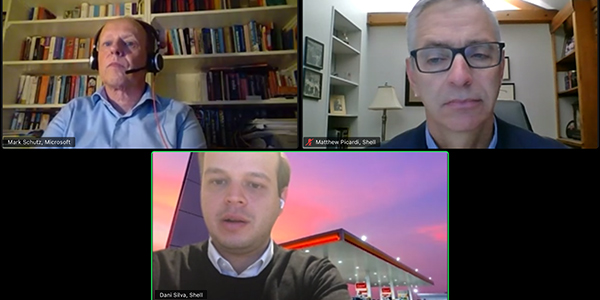When Microsoft set a goal of using 100% renewables by 2025 and becoming carbon negative by 2030, it realized it couldn’t do it on its own. So, it turned to … an oil company?
You heard that right, Mark Schütz, global senior digital strategy director for Microsoft, told a Northeast Energy and Commerce Association webinar last week.
Microsoft and Royal Dutch Shell, Europe’s largest oil-and-gas company, are now strategic partners on decarbonization efforts, the latest iteration of three decades of collaboration by the two companies. Digital technology will play a central role.
Artificial Intelligence, Solar and Wind
Shell will supply renewable energy to Microsoft to help the tech giant meet its targets, which includes erasing all historical emissions by 2050 through carbon capture and sequestration technology. Microsoft, in turn, will support Shell’s plans to use artificial intelligence to transform its operations to reach net-zero emissions by 2050 or earlier.
“It all started with our joint ambition,” Schütz said. “We were looking for partners, particularly in the energy industry, to make our ambitions reality. But [we also wanted] to make a greater impact with partners like Shell to accelerate the low-carbon transition worldwide.”
Shell currently has more than 1.6 GW of solar generation capacity through its operated facilities and joint-venture partnerships in North America. This includes a 43% stake in Silicon Ranch, one of the largest independent power producers in the U.S. with more than 120 solar facilities across 14 states. Shell’s 230-MW wind portfolio in North America includes interests in four onshore projects and energy obtained from eight partners. It has the potential to generate an additional 5 GW through joint-interest wind farms under development.
Shell and Microsoft have been working together on AI for three years. Forty-seven AI-powered proprietary applications have been deployed across Shell’s businesses this year, along with real-time technology to reduce carbon emissions in the company’s LNG operations. The new strategic alliance will accelerate the companies’ AI work to drive efficiencies further and reduce emissions.
Additionally, Microsoft has developed technologies to help keep Shell’s workers and sites safe, including the use of Azure cloud computing to power Shell’s autonomous integrity recognition system, which uses image recognition algorithms to detect when equipment or parts of a site are susceptible to corrosion. The two companies will advance the use of sustainable aviation fuels and plan to use Azure and data from Shell assets to strengthen operational safety by improving risk analysis, prediction and prevention.
Shell’s Transition
In 2017, Shell pledged to reduce the net carbon footprint of its energy products by about half by 2050, upping that in April 2020 with a pledge to reach net zero by mid-century. But it has known about the impact of carbon emissions on climate since the 1980s.
An internal report in 1988 reportedly predicted CO2 levels could double by 2030 and the potential disintegration of the West Antarctic Ice Sheet, resulting in a worldwide sea level rise of 5 to 6 meters, enough to flood low-lying countries. Rising air temperatures would “drastically change the way people live and work,” the company concluded. The company did not share the results of the report, however, which were disclosed by a Dutch news organization in 2018.
Shell, which has seen its stock price drop almost 60% this year, told investors last month its oil production might have peaked last year.
Daniel Silva, general manager for strategic enterprise development for Shell, said the transition to net-zero emissions is “really complex and will demand much more in-depth conversations on how we dive into those fundamental challenges.” Silva added that three principles guide Shell’s activities and initiatives on decarbonization: how to avoid emissions in the first place; if they are unavoidable, how they can be reduced; and how to remove and offset them.
Supporting Customers
Shell and Microsoft will work together on new digital tools to help Shell’s suppliers and customers reduce their carbon footprints. Silva said there is “absolutely no solution” that does not include customers as well.
“We are the biggest [mobility] retailer in the world,” Silva said. “We have more than 44,000 sites across the globe and have 30 million customers that come to our gas stations, every single day, so that’s a very relevant component.”
Shell and Microsoft are both customer-centric organizations, but customers’ behaviors and needs are changing, so “the customers of today will definitely not be the customers of tomorrow,” he said.
The sheer scale of Shell’s customer-facing sectors necessitates capital investment and partnerships like the one with Microsoft to achieve decarbonization, according to Silva, who is “super excited” to see the further use of AI and data-driven methods.
“We need to cater to the customers who go to our sites to buy coffee, or charge their electric vehicle, or buy premium gasoline or lubricants,” Silva said. “We need to make sure that that transition is done responsibly, working with our consumers, with policymakers and with the technology partners to be able to get there.”
Schütz said Microsoft recently announced a $1 billion Climate Innovation Fund to accelerate the development of carbon reduction, capture and removal technologies with a goal of carbon negativity.
“We need more technology tomorrow and the day after tomorrow, and we think we can best do that by working together to bring the new tools that we are developing, and also potentially Shell is developing, together with its expertise on energy,” Schütz said.
Silva concluded that Microsoft and Shell working together on technology initiatives is the best way to “fundamentally tackle” decarbonization.
“Each one of these elements will have carbon monitoring, and out of that, you will have renewables 24/7 or at least a high percentage of the time,” Silva said.




